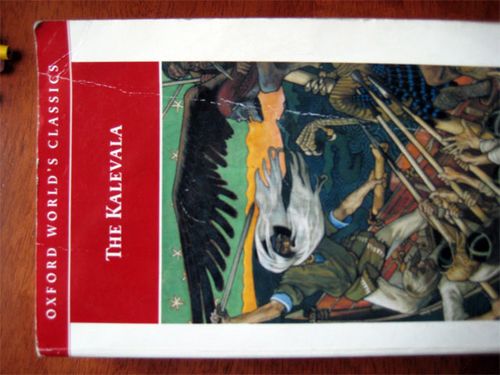I’ve been reading the*** Kalevala***, which is called "Finland’s national epic.” It reveals a lot about Finnish culture because it isn’t anything like other epics such as the *Odyssey* or *Beowulf*.
 At a cafe at the University of Oulu
At a cafe at the University of Oulu
Its characters are strictly local heroes, not acting on a national or international scene. All the action takes place in the "Kaleva district”, a mythical place you won’t find on the map, and in "Northland” or the "North Farm” which is a few days travel from the Kaleva district. (Although some people believe that these two places stand for Finland and Lapland.)
Also, there is very little fighting. More than once when a fight is imminent somebody opts for negotiation or magic instead. What fighting there is, is personal. It’s rarely organized enough or premeditated enough to rise to the level of war.
Instead, large sections of the book consist of very detailed descriptions of housework: how to bake bread, brew beer, forge iron, carve skis, clean the house, prepare the sauna, etc. There are also a lot of spells and incantations against illness, wounds, bears, etc.
The Kalevala has only four main characters:
Steady old Vainamoinen, called "the everlasting singer” is the most prominent man in the Kaleva district. Prosperous and wise, he is part shaman, part chieftain, and part bard. He has been old since the day he was born, and for this reason women don’t find him attractive. Despite his wealth and power, he is turned down every time he tries to get a young woman to marry him.
His friend Ilmarinen is called "the eternal smith.” He makes wonderful things out of all kinds of metals: iron, steel, tin, gold, silver and copper. He forges the magical Sampo for the Mistress of Northland.
Reckless Lemminkainen, also known as "Ahti” or "Farmind” is an impulsive hothead with very poor judgment. He is young and handsome and totally irresistible to women. He travels around Finland acquiring girlfriends and starting fights.
Louhi, Mistress of Northland, is the ruler of the North Farm and is also a witch almost as powerful as Vainamoinen. Her daughter is the beautiful Maid of the North. All three heroes (Vainamoinen, Ilmarinen, and Lemminkainen) woo the Maid of the North, but she marries Ilmarinen.
The Sampo is not a person, but it is an important part of the story. It is a mysterious object; something like a pepper mill made out of precious metals. It has three sides. When you turn the crank(s), it produces grain, salt and money, each product coming out of one of the three sides. Ilmarinen makes it for Louhi in return for marrying the Maid of the North, but eventually the heroes of the Kaleva district steal it from Northland.
In the Kalavala, every second line repeats the line before it. That is because these verses come from an ancient oral tradition and were meant to be sung out loud by two singers working together. The lead singer sings a line, and his assistant immediately composes a line which repeats and affirms what the lead singer has just said.
This example shows how the lines repeat themselves, and also illustrates the types of formulas the Kalevala employs – which are essential if you’re going to recite thousands of lines of verse:
*Annikki, she of good name girl of night, maiden of dusk keeper of a long twilight and morning’s early riser chanced to be at her washing and soaking her clothes at the end of a red stair on a broad landing on the misty headland’s tip at the foggy island’s end. She looks, turns her gaze round the lovely air towards the sky overhead shoreward by the seas: above, the sun shone below, the billows glittered. She cast her eyes seaward, turned her head to below the sun past Finlandia’s river-mouth past Vaino-land’s water’s end spied a black speck on the sea a bluish one on the waves.
She uttered a word, spoke thus she declared, chattered: ‘What are you, black on the sea who, bluish upon the waves? If you’re a gaggle of geese or a flock of dear ducks then waft into flight up into the sky! If you’re a shoal of salmon or some other school of fish splash into a swim take off into the water! Should you be a shoal of rock or a log in the water the billow would cover you the water wash over you.’*
The boat rolls nearer and the new craft sails past the misty headland’s tip past the foggy island’s end. Annikki, she of good name now saw ‘twas a boat coming a hundred-planked one tacking. She uttered a word, spoke thus: ‘If you are my brother’s boat or perhaps my father’s craft wend your way homeward and turn towards your own lands with your prow to these moorings your stern to other moorings! If you are a stranger’s craft float further away and make for other moorings with your stern to these moorings!
 Translated into English by Keith Bosley. I have also read the 1963 translation by Francis Peabody Magoun.
Translated into English by Keith Bosley. I have also read the 1963 translation by Francis Peabody Magoun.
From The Kalavala, Translated with an Introduction and Notes by Keith Bosley, Oxford University Press, 1989.

